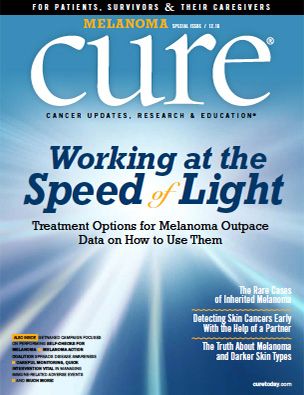Covering All the Bases: FDA Must Focus on Cancer Prevention
To best help the melanoma community, the FDA must not only approve medications, but also focus on cancer prevention.
While most of us think of the U.S Food and Drug Administration (FDA) as simply an agency that approves drugs or regulates the foods and beverages sold in our grocery stores, less well-known is the impact the FDA could have on the prevention of major, life-threatening diseases such as melanoma, which is expected to kill more than 10,000 people in the United States this year alone.
The FDA took a major step forward in the treatment of metastatic melanoma in 2011, when it approved Yervoy (ipilimumab), the first new drug for melanoma in 13 years and the first until that time to generate phase 3 clinical trial data demonstrating an overall survival benefit. Since then, a dozen new drugs and combinations have been approved for the treatment of melanoma, with one immunotherapy combination showing a response rate of about 60 percent in patients with metastatic disease.
With a wide array of exciting new drugs and drug combinations currently in clinical trials, most notably in the immunotherapy space, the FDA will continue to play a critical role in providing patients with effective treatments for melanoma.
The FDA, however, can do more by addressing a couple of issues that would help prevent thousands of people from developing melanoma in the first place. The first is rethinking how we approve new sunscreen filter technology. Filters are the physical or chemical ingredients in sunscreen that block, absorb or reflect the sun’s harmful rays.
Most melanomas in the United States are a result of ultraviolet (UV) radiation causing damage to the DNA of skin cells. The damage to DNA triggers a reaction that leads to the creation of a pigment to protect cells from this radiation. We see that pigment as tanned skin. The same process that causes a tan also releases an addictive endorphin that can make us want to sunbathe more. This means that we crave the very substance that makes us sick — just like people who are addicted to tobacco.
Although consumers appear to have an infinite number of choices when it comes to products that protect the skin from the sun, sunscreens available in the United States are all based on technology that is more than a decade old. In fact, the FDA has not approved a new sunscreen filter in over 15 years, even though Europe and Canada have been safely using products that include newer filters for years. Some of the products available in other countries block a much broader range of UV radiation, particularly in the cancer-causing UVA (long-wave) bands.
In 2014, the Public Access to SunScreens (PASS) Coalition — comprised of industry and nonprofit partners, including the Melanoma Research Foundation (MRF) — worked with the FDA and Congress to come up with a solution to this problem. The effort resulted in a new law requiring the FDA to create and implement a timely process for evaluating sunscreen filters.
Unfortunately, the FDA’s recently released draft guidelines on sunscreen filters recommend a level of testing that is costly, timeconsuming and of questionable value. Companies can reduce this onerous burden, but only by sharing proprietary and confidential information in a public hearing, something no company would voluntarily do.
But sunscreen is just one prevention issue on which the FDA needs to focus. The other is stricter regulation of the tanning bed industry. The UV lamps in tanning beds are classified by the World Health Organization as a carcinogen in the same category as tobacco smoke. Unfortunately, these UV lamps are heavily marketed to teens and young adults, who may not be aware of their inherent dangers. Finally, late in 2015, after years of work by the MRF and others, the FDA released draft rules barring access to tanning beds for anyone under the age of 18, and requiring tanning salons to check and certify their equipment regularly. Unfortunately, a year later, those rules have still not been finalized. The delay is frustrating, inexplicable and irresponsible, and hampers melanoma prevention efforts.
Whether it’s regulating tanning beds, figuring out the best way to test and label sunscreens or approving new melanoma treatments, close and frequent conversations between the FDA, industry and advocates are important. These discussions must remain flexible and encourage innovation. Doing so will assure melanoma activists that the FDA plays just as strong a role in approving and regulating melanoma prevention products and protocols as it does in approving and regulating ground-breaking treatments.
As we continue to learn more about the causes of melanoma and its potential cure, an effective FDA will be critical to improving and protecting the health of our citizens. I encourage each of you to contact your congressional delegation and urge its members to work with the FDA to find a better process for evaluating sunscreen filters, and to support the FDA’s proposed restriction on tanning beds. Through your efforts, we can help change the melanoma landscape and save thousands of lives.
Timothy Turnham, Ph.D., is executive director of the Melanoma Research Foundation. Prior to joining the MRF, Turnham served as chief executive officer of the Colon Cancer Alliance and director of development for United Cerebral Palsy Associations. He holds a B.A. in microbiology from the University of Tennessee, an M. Div. from the New Orleans Baptist Theological Seminary and a Ph.D. from the Southern Baptist Theological Seminary.
